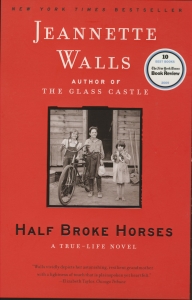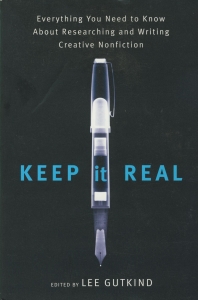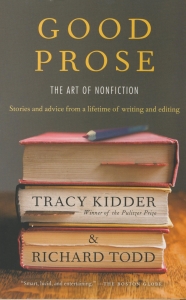Is Your Life Writing Creative Nonfiction or is it Fiction?
There was a day when history writers didn’t care one bit whether or not you enjoyed reading their tomes. It was serious stuff intended for scholars—and deadly dull to the general reader. Fortunately that’s changing, thanks in part to creative nonfiction. In this new form writers inject life-giving sensory details (ala fiction), while holding true to the facts. The end result is a burgeoning nonfiction readership, and the envy of fiction writers who have developed a style they call “true life novels.” In the clamor to write true life stories the lines have become blurred. When is a piece of history, memoir or personal writing fiction and when is it nonfiction?  The answer is simple. If you recreate dialogue (except in memoir, in which recreated ‘as remembered’ dialogue is acceptable) or scenes without the caveat of words such as likely, would have, may have been –you’re writing a true life novel. Jeannette Walls’ book Half Broke Horses, based upon her grandmother’s life, is a terrific example. Jeannette says she crossed the line into fiction to give the narrative more immediacy. “I wanted to capture her voice,” says Walls in a YouTube video http://www.youtube.com/watch?v=lOKkcBPYl5Y. Jeannette also felt the story would have much greater impact in a first person perspective, rather than the usual God-like third-person form of most history writing—presented through the filter of the objective historian. http://bookpage.com/interviews/8525-jeannette-walls#.U6HZU8JOVpg.
The answer is simple. If you recreate dialogue (except in memoir, in which recreated ‘as remembered’ dialogue is acceptable) or scenes without the caveat of words such as likely, would have, may have been –you’re writing a true life novel. Jeannette Walls’ book Half Broke Horses, based upon her grandmother’s life, is a terrific example. Jeannette says she crossed the line into fiction to give the narrative more immediacy. “I wanted to capture her voice,” says Walls in a YouTube video http://www.youtube.com/watch?v=lOKkcBPYl5Y. Jeannette also felt the story would have much greater impact in a first person perspective, rather than the usual God-like third-person form of most history writing—presented through the filter of the objective historian. http://bookpage.com/interviews/8525-jeannette-walls#.U6HZU8JOVpg.
What is Creative Nonfiction?
Impactful scenes and sensory-loaded passages can be achieved within the confines of strict adherence to the facts too. And when you do, you’re writing creative nonfiction. Offer telling details gleaned from your research sources, short quotes from a diary or letter as a dialogue stand in, and recreate the moment through your own experiences of a similar weather pattern or location and your writing will gain immediacy. (For more on writing scenes see http://thescribes.ca/scenes-to-bring-family-history-writing-to-life/)  There are other ways writers are pushing the boundaries within creative nonfiction. While the form is thought to be new, it’s not. Boswell’s Life of Samuel Johnson, written 1791, presents the author’s personal perspective—a hallmark of creative nonfiction. Modern biographers like Nuala O’Faolain have pushed the style further, writing themselves into history-based subjects with whom they share a common experience. Lee Gutkind, a leader in the creative nonfiction movement, defines the style as “literary craft”, prose about real people and events—delivered “in a compelling, vivid manner.” The anthology he edited, aptly titled Keep it Real, defines the style. For more on Gutkind see his website: https://www.creativenonfiction.org/authors/lee-gutkind Voice & Vision by Pyne and Good Prose by Kidder and Todd also provide solid advice for ways to bring history to life. Both books warn urge us not to lose sight of the need to provide readers with thoughtful analysis and author perspective, as well as lifelike spark.
There are other ways writers are pushing the boundaries within creative nonfiction. While the form is thought to be new, it’s not. Boswell’s Life of Samuel Johnson, written 1791, presents the author’s personal perspective—a hallmark of creative nonfiction. Modern biographers like Nuala O’Faolain have pushed the style further, writing themselves into history-based subjects with whom they share a common experience. Lee Gutkind, a leader in the creative nonfiction movement, defines the style as “literary craft”, prose about real people and events—delivered “in a compelling, vivid manner.” The anthology he edited, aptly titled Keep it Real, defines the style. For more on Gutkind see his website: https://www.creativenonfiction.org/authors/lee-gutkind Voice & Vision by Pyne and Good Prose by Kidder and Todd also provide solid advice for ways to bring history to life. Both books warn urge us not to lose sight of the need to provide readers with thoughtful analysis and author perspective, as well as lifelike spark.
Choosing Between Fiction and Nonfiction
Scenes are the lifeblood of good storytelling. Vivid details are at hand for those writing memoir or biography of a living subject, but for other nonfiction writers they can be a challenge, and a demand for creative—though not inventive—process. When you achieve it the rewards are rich. If you feel constrained by this and want to bust out into recreations to get your point across, cross over to fiction.  Dialogue is the means by which scenes and the story unfolds through dramatic action in fiction. If you feel your story needs this to gain life or convey nuances of meaning then—again—maybe your family history or biography needs to be recast as fiction? In nonfiction, unless you’re working with a living subject, the best we can usually achieve for dialogue is short quoted excerpts from diaries or letters. Whatever choice—be it true life novel or creative nonfiction—your honesty about your process and storytelling devices, in the prologue and the words you choose to expose your hand, will gain and hold readers’ trust and engagement.
Dialogue is the means by which scenes and the story unfolds through dramatic action in fiction. If you feel your story needs this to gain life or convey nuances of meaning then—again—maybe your family history or biography needs to be recast as fiction? In nonfiction, unless you’re working with a living subject, the best we can usually achieve for dialogue is short quoted excerpts from diaries or letters. Whatever choice—be it true life novel or creative nonfiction—your honesty about your process and storytelling devices, in the prologue and the words you choose to expose your hand, will gain and hold readers’ trust and engagement.
